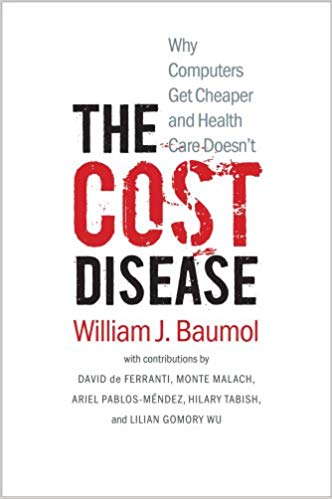Pay no attention to the blunt and horrifying title, a crude attempt to capture your attention. Now that you’re here, please contain your outrage and read on to learn the nature and symptoms of the disease, how the diagnosis was made, and what is prognosticated.
On Disease
In healthcare, practitioners comb the mortal being to identify disease, first by symptomology:
- “My ear hurts.”
- “I can’t hear the TV.”
- “I hear voices.”
Then by observation and measurement–looking for anomalous, damaged, infected or traumatized anatomy and malfunctioning physiology.
If a disease condition is diagnosed, treatment plans vary depending on whether there is a cure or the condition is chronic:
- “We’ll patch your eardrum so it won’t hurt and your hearing will be restored.”
- “Hearing aid will help you hear better but you’ll need periodic hearing evaluations and device adjustments from here on out.”
On occasion, economists use the concept of disease as metaphor for market malfunctions (e.g., “growth stagnation” “stagflation” “supply side failure”). As in healthcare, they go from symptoms to observation and measurement to make the ID. If implementable solutions exist, the disease can be cured.

The Cost Disease, by William Baumol, courtesy Amazon
If the condition resists solutions or solutions don’t exist, the disease is chronic at best and fatal at worst. Such is the case with healthcare and, by extension, with hearing healthcare, according to economist William J Baumol, who wrote a clear, fast-paced book describing the “cost disease” in healthcare and other personal service endeavors. All quotes in this post are from his book.
Baumol’s Cost Disease: Our Case in Point
Dr. Baumol delved deep into labor markets, innovation, entrepreneurship, and economic history. In particular, he looked at economic productivity–output (e.g., revenue) per unit of input (e.g., labor).
In Manufacturing – Better Hearing Aids at Lower Production Costs
Baumol wasn’t concerned about productivity in the manufacturing sector, where technological innovation drives constant productivity improvement as a primary means of besting competitors and growing markets.
“Since the Industrial Revolution, labor-saving productivity improvements have been occurring at an unprecedented pace in most manufacturing activities, reducing the cost of make these products even as workers’ wages have risen.” (p xvii)
Productivity goes up with technological advances because workers can produce more units at lower cost in the same amount of time. This makes workers more valuable so wages also go up in a well ordered market, keeping pace with growth though perhaps not growing the labor force. That works for widgets, and also works for hearing aids, as Hearing Economics has discussed in many past columns.
In hearing healthcare we have seen the effect for years, manifest in ever-improving hearing devices and ever-widening range of products and price points (see 8-post 2016 Pricing series for this discussion). It’s a healthy condition and is likely to stay that way, at least for the most competitive players.
Diagnosis and treatment: Hearing aid devices and manufacturers don’t suffer from Baumol’s cost disease; no treatment needed.
In Healthcare Delivery – Better Hearing Outcomes at Higher Costs
Productivity isn’t so easy in the service sector. Baumol realized that “personal services”, notably in healthcare and education, don’t proceed with widget productivity logic. It’s a matter of face time requiring:
…direct face-to-face interaction between service providers and consumers. Doctors, teachers, librarians, hair dressers all have jobs that require in-person contact… automation is not always possible, and labor-saving productivity improvements occur at a rate well below average for the economy. (from first 20 pages of Baumol book, roughly paraphrased)
Audiologists, for example, can’t diagnose hearing problems much faster than we did back in the 80s, nor can we effectively counsel, fit, program, and orient patients to amplification faster than in days of yore. The procedures have changed a lot but not so much the time required to do them.
Audiologists are stalled out –we’re no more productive than we were back in the day. But our wages continue to rise to keep up with inflation, cover education costs (another “personal service” industry) that are rising faster than inflation, and deter us from straying off to better-paying fields.
This is Baumol’s conundrum: service wages must rise on the back of stalled productivity while manufacturing labor costs rise naturally on the back of increasing productivity. The result is increasingly expensive (some would say inefficient) services to administer increasingly efficient devices.
We keep getting paid more but we can’t cut our time to boost our productivity. And yet, the more goods supplied at lower cost, the more services demanded at ever increasing cost, no end in sight. We’re not pricing ourselves out of the market and neither are other personal service providers. Reports on US labor growth surely support the diverging trends in personal services versus manufacturing and technology: June payrolls increased by 46,000 for health and education services, compared to 12,000 for manufacturing and a decrease of 2,000 for IT technology.
Diagnosis and treatment: All licensed hearing healthcare providers, and those who support them, suffer from Baumol’s cost disease; treatment plan yet to be determined.
It’s a Chronic Condition but Probably Not Fatal
Baumol concluded there was no cure for our cost disease but he didn’t think it would kill us by pricing us out of the market. Instead, he developed economically sound ideas on how to manage it long-term, on the reasonable assumption that the market needs us. Those ideas will be examined in a future post.
Meantime, the knee jerk reaction of many stakeholders to rising Price is to cut, manage and regulate “it,” with little if any time spent defining what, exactly “it” is. In the present milieu we see that view exercised and aimed at hearing aids in general, which sounds good but isn’t of much help to consumers or providers.
Baumol’s view is at once simpler and more faceted, never straying from basic economic principles:
It is wrong to interpret the cost disease as a failure of the market’s pricing behavior. The market does give the appropriate cost signals, reporting correctly that the amount of labor required to supply services is declining little or not at all so the costs of services rise persistently in comparison with manufactured products. (paraphrased pp 61-63)
Service Costs aren’t Device Costs, Ditto for Pricing
Maybe Baumol was the first unbundler; he certainly saw the market pricing problem long before we did and in bigger terms. But we’re catching the drift: consider this comment by Barry Freeman to a recent Hearing Economics post by Amyn Amlani, both of whom make the case for data-driven unbundling analyses:
For years we have talked about separating the cost for the product and the cost to deliver the product (unbundling). Another way to view your analysis is to say that we have not improved the efficiency of the delivery system and the costs per hour have remained unchanged or maybe even have increased. Maybe a future analysis would separate out the cost for the product and look more specifically at the costs of the delivery system.
Thank you, Drs Freeman and Amlani. Let’s hold the thought and continue the Baumol discussion in a future post at HHTM.
 Holly Hosford-Dunn, PhD, owned and operated a dispensing audiology practice in Tucson and was active in management of HearingHealthMatters.org through 2017. She holds BA degrees in Communication Sciences, Psychology and Economics; MA in Communication Disorders; PhD in Hearing Sciences. Following post-doctoral work at Max Planck Institute (Munich, DE) and Eaton-Peabody Auditory Physiology Lab (Boston), she joined the Stanford medical school faculty as director of audiology. She has authored/edited numerous text books, chapters, journals, and articles and taught Marketing and Practice Management in a variety of academic settings. She continues to consult and write on topics related to hearing health care vis-à-vis consumer demands, professional training, technological advancement, capital investment, industry consolidation, regulatory control, product and service distribution, and strategic pricing.
Holly Hosford-Dunn, PhD, owned and operated a dispensing audiology practice in Tucson and was active in management of HearingHealthMatters.org through 2017. She holds BA degrees in Communication Sciences, Psychology and Economics; MA in Communication Disorders; PhD in Hearing Sciences. Following post-doctoral work at Max Planck Institute (Munich, DE) and Eaton-Peabody Auditory Physiology Lab (Boston), she joined the Stanford medical school faculty as director of audiology. She has authored/edited numerous text books, chapters, journals, and articles and taught Marketing and Practice Management in a variety of academic settings. She continues to consult and write on topics related to hearing health care vis-à-vis consumer demands, professional training, technological advancement, capital investment, industry consolidation, regulatory control, product and service distribution, and strategic pricing.






